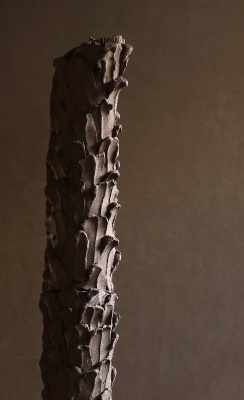Descripción de la Exposición
Every language has its own idea of what constitutes a word. In English, mustard is a word but moutarde is not. In French, the inverse is true. The interplay of words in a cryptic crossword offers an interesting disparity between language and image. Imagine bacteria living in a subzero artic frost… Scientists in the far northern reaches of Canada have collected and cultured about 200 microbes, putting the organisms in a simulation of their native environment to find the one best suited to life in extreme conditions. This turned out to be a strain of Planococcus halocryophilus, which makes its home in tiny veins of salt water in the Arctic permafrost. The bacteria can reportedly grow in these conditions and survive at temperatures down to negative 25 degrees Celsius. Oh! Though the fact that these bacteria can survive at such temperatures is amazing in itself, one could also consider the possibility of similar strains (living or dead) existing in the comparably frigid, salty environments of Mars or Saturn’s moon Enceladus. Locked in the frozen vaults of Antarctica and Greenland – in the same manner that words are locked in a crossword – a lost world of ancient creatures awaits another chance at life. The Organ: As the Ground Becomes Exposed, an entirely new piece produced by Julieta Aranda for the TANK, acts exactly like a time capsule from the distant past. It is a storehouse of words in the same manner that the polar ice sheets are a storehouse of bacteria. The work offers a cryptic glimpse into the life of the many millions of tiny organisms that may have been frozen longer than humans have walked this planet, biding their time until conditions change and they are set free. Aranda’s installation at the TANK is informed by her long-term research on the relationships that art establishes with life, experience, time, and information at many levels. In concert with the ongoing seminars conducted by Filipa Ramos and Chus Martínez, this newly commissioned work opens new ground for scientists and artists alike to explore these relations and their crucial role in art practice today.
In this installation conceived for the TANK, Aranda has produced a kind of totally new “organ” that allows us to see the future of sculpture and perception while also more fully sensing the relationships that art establishes with the questions and debates populating our everyday lives.
The TANK’s exhibition program helps us think about certain issues. We have seen art take on the role of a producer of certain experiences which are different from others and which bear no relation to function. At the TANK, we invert this idea to see art and artworks not as producers of certain feelings or experiences, but as organs that have historically developed and that actually feel us, that feel the world.
Other recently commissioned artworks at der TANK include Fabian Marti’s artist guesthouse, a tree by Swiss artist Johannes Willi, and a labyrinthine installation by French artist Mathilde Rosier.
Aranda’s The Organ: As the Ground Becomes Exposed has been made possible by the first collaboration between the Art Institute and artEDU Foundation.
Julieta Aranda was born in Mexico City and divides her time between Berlin and New York. She teaches regularly for the master seminar Art & Science at the Art Institute in Basel. Aranda holds a BFA in filmmaking from the School of Visual Arts, and an MFA from Columbia University, both in New York. Aranda is co-director of e-flux.
Her explorations span installation, video, and print media, with a special interest in the creation and manipulation of artistic exchange and the subversion of traditional notions of commerce through art making. Aranda’s body of work exists outside the boundaries of the object. Her installations and temporary projects, which often examine social interactions and the role that the circulation of objects plays in the cycles of production and consumption, are intensely site-specific.
Aranda was an artist in residence at Iaspis in Stockholm, as well as at the International Residence at Recollets in Paris. Her work has been exhibited internationally, in venues such as the 56th Venice Biennale (2015); the Guggenheim Museum, New York (2015, 2009); Kunsthalle Fridericianum, Kassel (2015); the 8th Berlin Biennale (2014); Berardo Museum, Lisbon (2014); Witte de With (2013, 2010), Rotterdam; Museo d’Arte Contemporanea Villa Croce, Genova (2013); MACRO Roma (2012); Documenta13 (2012); N.B.K. (2012); the Gwangju Biennial (2012); the 54th Venice Biennial (2011); the Istanbul Biennial (2011); Portikus, Frankfurt (2011); New Museum, New York (2010); Kunstverein Arnsberg (2010); MOCA Miami (2009), Museum of Contemporary Art, Chicago (2007); the 2nd Moscow Biennial (2007); MUSAC, León (2010 and 2006); and the VII Havana Biennial, amongst many others.

Actualidad, 14 nov de 2016
Salcedo, Neto, Marcelle, Dávila, Aranda y Vasconcelos exponen fuera de sus países
Por ARTEINFORMADO
Presentan nuevas producciones o proyectos site specific en centros, museos y galerías de Estados Unidos, Suiza y Dinamarca.

Exposición. 17 abr de 2025 - 03 sep de 2025 / Centro Cultural Andratx (CCA) / Andratx, Baleares, España

Formación. 08 may de 2025 - 17 may de 2025 / Museo Nacional Centro de Arte Reina Sofía (MNCARS) / Madrid, España